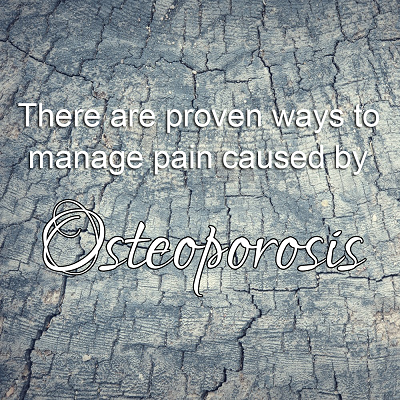 Osteoporosis can cause pain and discomfort for many of those afflicted with the condition. In too many cases sufferers don’t realize the pain is due to osteoporosis. This is because until osteoporosis is specifically diagnosed, most people are unaware they have it.
Osteoporosis can cause pain and discomfort for many of those afflicted with the condition. In too many cases sufferers don’t realize the pain is due to osteoporosis. This is because until osteoporosis is specifically diagnosed, most people are unaware they have it.
Therefore, they tend to blame their aches on pains on other conditions, such as arthritis, or simply ‘back pain’. Often, a diagnosis only occurs following a bone break. Once a diagnosis has been made and acknowledged by the patient, a focus on remedial treatment and pain relief can be undertaken.
As osteoporosis is a very common condition there have been many treatments tried and tested. Listed below are treatment options others have found effective in managing the pain associated with osteoporosis.
Hot or Cold Treatment
Using either hot or ice packs can be very effective in alleviating pain caused by osteoporosis. If you find yourself feeling stiff in the morning try a warm bath. Warm water can help loosen up the stiffness.
Alternatively, if it is too painful to move, use a cold pack to reduce any joint inflammation and swelling. The use of a cold pack can also help numb the nerves sending the pain signals, which will reduce the intensity of the pain.
You can make your own cold packs by placing frozen beans or peas into a re-sealable plastic bag. This type of home-made ice pack can more easily follow the body shape than many commercial products, allowing the coldness of the pack to penetrate easily into uneven or oddly shaped area.
TENS (Transcutaneous Electrical Nerve Stimulation)
A TENS device makes use of electrical impulses to block pain signals in the body. Electrodes are placed on the skin near the painful area and then a mild electric current is transmitted. This action prevents pain signals from being sent to the brain, thereby giving relief. It’s important not to use a TENS device without the supervision of your physician or physical therapist.
Acupuncture
Acupuncture is commonly applied for relieving pain caused by many illnesses and diseases. Acupuncture also helps the body to re-adjust its energy flow and as such, works to repair as well as alleviating pain.
Researchers have found that acupuncture can help increase bone density as much as 8.8%. Plus, their research showed that acupuncture can help increase the levels of osteocalcin, which is a biomarker of bone formation, by up to 30.9%.
Biofeedback
This technique helps people cope with pain, as it teaches them how to use their own body’s responses to alleviate the stress and pain caused by osteoporosis. During biofeedback sessions, sensors are attached to the body to measure the temperature of the extremities, heart rate and muscle tension.
Biofeedback sessions are performed under the supervision of a health care provider, cardiologist or urologist. Biofeedback can also be used in conjunction with cognitive-behavioral therapy.
Emotional Freedom Technique
EFT practitioners believe that when unhealthy habits, past traumas, unhappy memories and any other negative emotions are stored in the body, a disruption in its energy flow begins to occur.
This circumstance increases the incidence of many diseases that bring about pain and discomfort, including osteoporosis. Using EFT, or Emotional Freedom Techniques, the person will be able to help correct these energy imbalances, and healing can start to take place.
Realizing that osteoporosis is the cause of much of their pain comes as a shock to many newly diagnosed patients. Several methods exist to manage osteoporosis pain, so choose one or more that best suits your own particular set of conditions.






